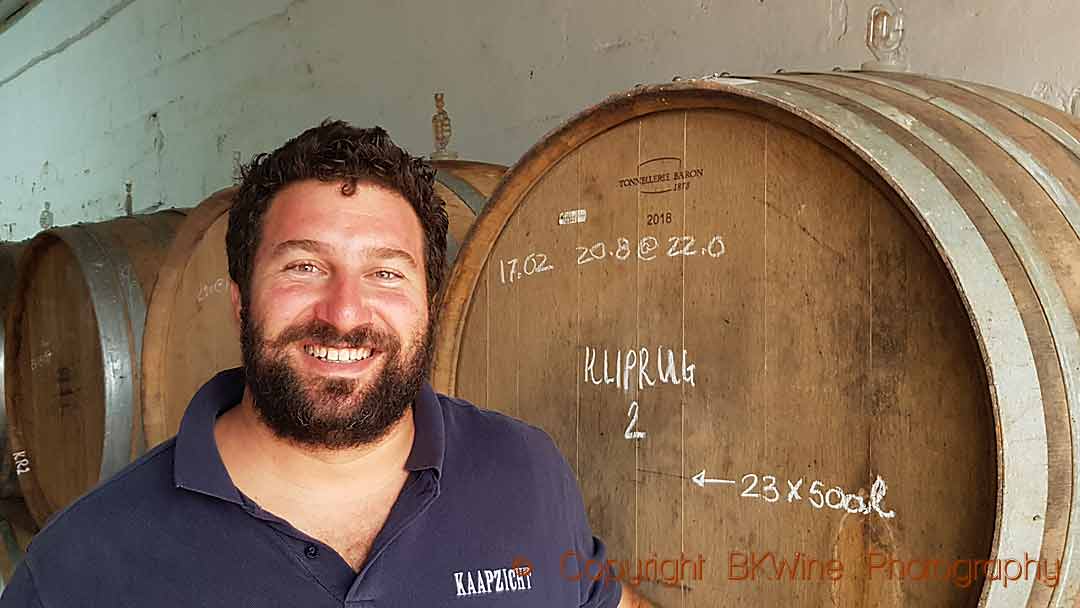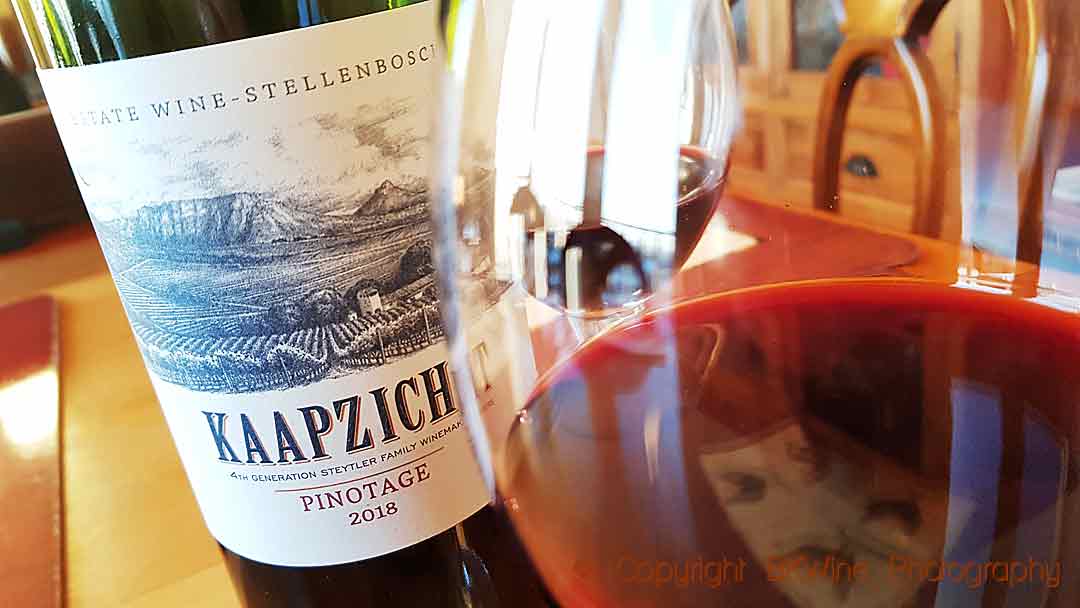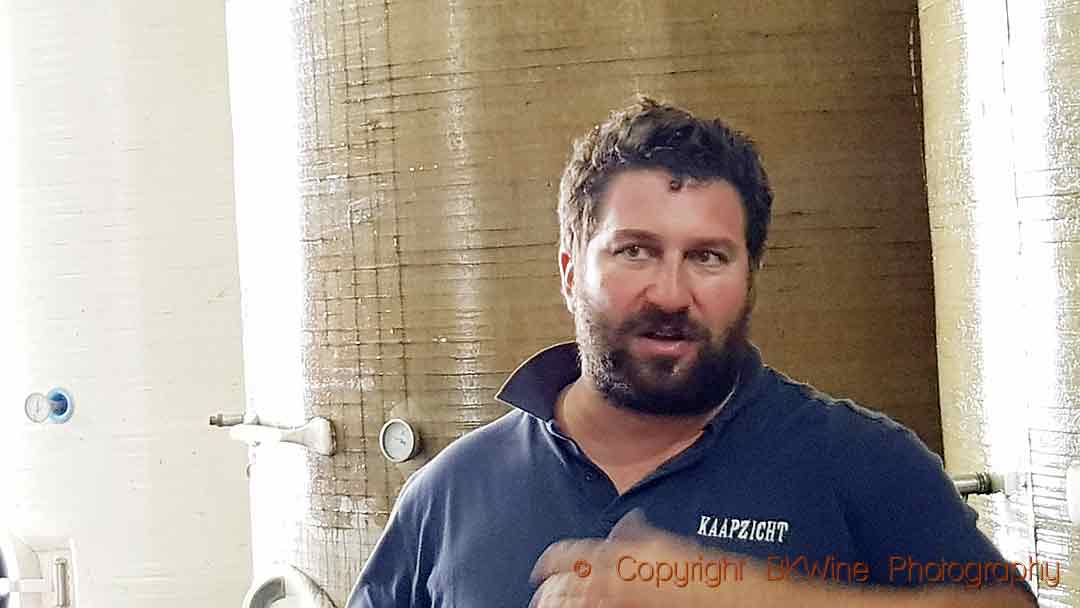The Steytler family has owned Kaapzicht Wine Estate for four generations. Today, it is run by Dani Steytler Jr and his wife Carin. They make a wide range of wines from 21 different grape varieties. I met Danie Jr in the cellar in the middle of harvest and talked to him about two of the exciting projects that he is involved in. First, the Stellenbosch Cabernet Collective. Secondly, one of his favourite grapes, pinotage and why it is a grape that more people should discover.
But before we dive into cabernet and pinotage, let’s take a quick look at Kaapzicht Wine Estate. It is a winery in Stellenbosch, South Africa’s most famous wine region. It is a short drive, 20 minutes, north-west of the town of Stellenbosch in the direction of Cape Town. South Africa has defined a hierarchy of wine denominations, but it is not something that has settled very much in the minds of consumers. At least not yet. We are in the Coastal Region, more specifically, we’re in the Stellenbosch District. Stellenbosch, in turn, is divided into several “wards”. Kaapzicht is in the Bottelary ward. Other famous wards in Stellenbosch are Banghoek, Devon Valley, Jonkershoek Valley, Papegaaiberg, Polkadraai Hills, and Simonsberg, but there are more.
An article in our series of talks with South African winemakers. Read all here:
- Springfontein Wines, surprising and extraordinary South African
- Hidden high up in the Stellenbosch mountains is a gem, Oldenburg Vineyards
- Kaapzicht, a pinotage pioneer and cabernet champion in Stellenbosch
- Both classic and unusual, Stark-Condé Wines in Stellenbosch, South Africa
- Aslina Wines, Ntsiki Biyela’s new venture, and the future of South African wine
- DP Burger at Glenwood Vineyards in Franschhoek, South Africa
And also:
This is a longer version of an article published on Forbes.com.
Kaapzicht Wine Estate
Today, most of the different wards don’t have very distinct separate identities or characteristics. But that will probably change with time. As Danie Steytler Jr says, “Helderberg (wines have) more tightly wound tannins, wines that can really age very well. We at Bottelary have slightly warmer, more northwestern orientation, so better or longer afternoon sunlight, which then creates maybe riper tannins.” It will be interesting to see how these sub-region styles develop with time.
The farm came into the hands of the Steytler family in the 1940s. At the time, it was called Rozendal. They were one of the pioneers to plant pinotage, a crossing of pinot noir and cinsault made by Professor Perold at Stellenbosch University in 1925 but not used commercially until the 50s. The first pinotage wine came on the market in 1959 from the Lanzerac winery, and in the same year, Kaapzicht planted its first pinotage vines. However, it was not until 1984 that the winery got its current name. That year, the family decided to bottle wine under its own new name, Kaapzicht, which led to them leaving the local cooperative. At the time, the South African wine industry was very dominated by the co-operatives.
Today, it is a relatively big farm with over 160 hectares of vines of more than 20 varieties. The focus is on chenin blanc, cabernet sauvignon and pinotage, but with more than fifteen different wines, there’s a lot of variety. Read more on the Kaapzicht site.
Developing regional characteristics
One of the reasons it was particularly interesting to talk to Danie Steytler Jr was his interest in cabernet and pinotage. Many wineries have a multitude of different grape varieties planted, just like Kaapzicht. But more and more, wine regions are profiling themselves with one or a few specific grape varieties that they think are particularly suitable for the area. Stellenbosch is making a name for itself for cabernet sauvignon and pinotage. Other examples are Hemel en Aarde in the Walker Bay region, which focuses on cool-climate varieties, like pinot noir and chardonnay. Up north, where it is warmer, we have Swartland, where you find a lot of “hot-climate” grapes, like grenache and syrah, that come from the more southern European regions.
This is an exciting evolution in a country rapidly positioning itself as a leading New World wine producer with many exciting top-quality wineries. In a longer perspective, it may help to create more specific identities for the different regions in the minds of the consumers. Today, very few can say that they have an idea of the difference between the South African regions.
Talking to Danie a while back, in February of 2020, I wanted, in particular, to understand how he sees the potential of cabernet sauvignon and pinotage in Stellenbosch and, of course, in particular at Kaapzicht.
The Cabernet Collective
Danie is involved in a project called The Stellenbosch Cabernet Collective, which was the perfect starting point for our conversation. What is the Cabernet Collective? I asked Danie.
“I’m a member of the Stellenbosch Cabernet Collective. So we have 28 members, I think, now. It started three or four years ago. Christo Le Rich from Le Rich Wines is heading the whole thing up. All the big names are in, Kanonkop, Simonsig, Rust en Vrede, Glen Ellen… they’re all part of it. The idea behind the collective is to showcase Stellenbosch cabernet, to say, ‘this is this is what we do really well’ and speak as one voice, not as one producer, but rather as a region saying ‘This is what’s good from our region’.”
So, is it a way to find a common identifier to talk to the world?
“I think the South African industry comes from a place where everyone’s got everything. We on this farm, we’ve got 21 varietals. My father wanted to experiment and try new things. I think our generation will now take what we have and say, ‘Right, this works really well. This doesn’t work so well, so those vines must come out.’ For example, here (at Kaapzicht, Stellenbosch), pinot noir, sauvignon blanc – my feeling is that on this site, it’s too warm for those varieties. But cab and pinotage and chenin work really well. So, we focus on those and kick out what doesn’t work. And cabernet works really well in Stellenbosch.”
What kind of specificities do you have with cabernet from Stellenbosch?
“I think the soils and the region are diverse. We have smaller sub-regions. We (Kaapzicht) are in Bottelary, but you’ve got the Simonsberg, you’ve got the Helderberg, you’ve got Stellenbosch Kloof, Stellenbosch Mountain… These are the smaller wards. The wines are very different between Bottelary and Helderberg, for example.”
“But one thing is universal. We have granitic soils, pretty much most of us anyway. And that’s really good for the varietal. It’s interesting as an area to have. Helderberg is probably more tightly wound tannins, wines that can really age very well. At Bottelary, we have slightly warmer, more northwestern orientation, so better or longer afternoon sunlight, which then creates maybe riper tannins.”
Stellenbosch is the most important cabernet region in South Africa. More and more, we hear winemakers voice the opinion that Stellenbosch cabernet deserves more attention, just like Danie is saying. Cabernet Sauvignon has proved to be well-suited to Stellenbosch. It likes the heat and is drought-tolerant. There are almost 3,000 hectares in Stellenbosch out of a total of some 15,000 hectares. Stellenbosch is hot and dry in summer, but seldom too hot and the vineyards enjoys cool breezes from False Bay in the afternoon It rains mainly in the winter. Some producers irrigate their vineyards, and some do not, depending on the soil, which is very varied in the region. The surrounding mountains also give the vineyards varying degrees of exposure to wind and sun. Read more on how different producers deal with it in this article on Stellenbosch cabernet on BKWine Magazine.
Read more on The Cabernet Collective in Stellenbosch here.
Pinotage, the unique South African grape variety
Talking about another grape variety that I have the impression Danie is very fond of, the pinotage. Pinotage is a grape variety that is maybe struggling a little bit on the international market with a not excellent reputation. Why are you so fond of pinotage? I asked Danie.
“It’s proudly South African. It’s a varietal that Professor Perold created at Stellenbosch many years ago; in 1925, he created it. In 1953, it was planted for the first time just here, just down the road. So it’s something that that is our own. As far as reputation goes, it’s a wonderful grape. People just don’t get enough opportunity to taste it.”
Pinotage is a crossing between pinot noir and cinsault. The idea was to get the elegance from pinot noir and cinsault’s climate adaption and productivity. In reality, it turned out quite differently, as is often the case when one makes a crossing. Pinotage is usually much more dense and concentrated than either of its parents.
Is it challenging to grow and make wine from?
“I think that maybe like pinot noir, which is one of its parents, it’s very site-specific or terroir driven. So, I think, like any grape, if we have planted it outside of where it wants to be, it doesn’t make the best wines. I think pinotage does really well here in Stellenbosch, in Bottelary specifically. If you look at the producers in this area, you’ve got Kanonkop, L’Avenir, Simonsig, Beyerskloof. All in a five-kilometre radius, and they’re all really good at making pinotage. So, you know, we try and follow suit and also try to make a good pinotage. I put a bit of effort and love into the product, and I think the wine’s really nice. “
Or, as another pinotage winemaker pointed out, it has only been making wine in any quantity since the early 60s, so it has been just over 60 years. So it is not surprising that it has taken some time to understand how best to work with it. Many other grape varieties have centuries of experience.
What are the characteristics of a really good pinotage? How do you like them?
“I’m maybe more old school; I quite like the bigger, fuller style. That’s how I was brought up. My father made big rustic, wooded, heavy-style pinotage. I think that what’s exciting is the more modern approach; the younger generation is looking at making wines that are slightly lighter, lower in alcohol, more fruit-driven, less oak, more elegant, and more towards the pinot noir styles. That’s the more modern or new style, which we’re also testing and trying out. I’ve got a couple of barrels just around the corner, which are my new 2020 lighter-style pinotage, which we will hopefully roll out at the end of the year. But personally, I still like a big pinotage to go with my steak.”
When I talked to Danie, it was just in the middle of the 2020 harvest in February, at the end of Feb.. How is the harvest 2020 for you? I wondered.
“It’s good, for a change. We’ve got a decent harvest. We’ve had really small crops since 2014. It’s been very dry and hot in South Africa for the last five years. This year (2019-2020), it wasn’t extremely hot. I think we got just over 400 mil (millimetres of rain), so, still, very little rain. But the rains came at the right time. It looks like we’re going to get 6-7 tonnes per hectare which for us is good. It’s a good vintage. Quality looks good too. It’s hard to tell this early. I mean, you can hear stuff still fermenting, but from what the grapes look like and what the juices taste like, I’m very excited now.”
Good prospects for 2020! And an excellent future for cabernet sauvignon and pinotage from Stellenbosch, judging from what we have tasted.
Travel
You can discover many of the fabulous South African wines on a wine tour to South Africa with BKWine Tours, also including Franschhoek, Walker Bay, Elgin, Stellenbosch and much else.
Travel to the world’s wine regions with the wine experts and the wine travel specialist.
The most insightful wine tours. BKWine wine tours.
















